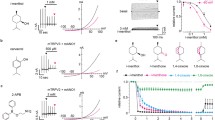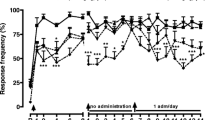Abstract
Sodium ferulate (SF) and Oxymatrine (OMT) were compounds extracted from Chinese herbs, and have been used in clinical treatment of heart and hepatic diseases, respectively, in China for many years. The objective of this study was to examine the analgesic effect and the mechanism of the combined treatment of SF and OMT. Using the animal pain models by applying Acetic Acid Writhing Test and Formalin Test, the combination of SF and OMT showed significant analgesic effect in dose-dependent manner. In vitro, the combined treatment inhibited the increase in intracellular calcium concentration evoked by capsaicin in the dorsal root ganglion neurons. Importantly, a synergistic inhibitory effect of SF and OMT on the capsaicin-induced currents was demonstrated by whole-cell patch-clamp. Our results suggest that SF and OMT cause significant analgesic effect which maybe related to the synergistic inhibition of transient receptor potential vanilloid-1.








Similar content being viewed by others
References
Ogiwara T, Satoh K, Kadoma Y et al (2002) Radical scavenging activity and cytotoxicity of ferulic acid. Anticancer Res 22:2711–2717
Wang BH, Ou-Yang JP (2005) Pharmacological actions of sodium ferulate in cardiovascular system. Cardiovasc Drug Rev 23:161–172
Masuda T, Yamada K, Maekawa T et al (2006) Antioxidant mechanism studies on ferulic acid: identification of oxidative coupling products from methyl ferulate and linoleate. J Agric Food Chem 54:6069–6074
Srinivasan M, Sudheer AR, Menon VP (2007) Ferulic acid: therapeutic potential through its antioxidant property. J Clin Biochem Nutr 40:92–100
Chen XS, Wang GJ, Cai X et al (2001) Inhibition of hepatitis B virus by Oxymatrine in vivo. World J Gastroenterol 7:49–52
Honore P, Wismer CT, Mikusa J et al (2005) A-425619 [1-isoquinolin-5-yl-3-(4-trifluoromethyl-benzyl) -urea], a novel transient receptor potential type V1 receptor antagonist, relieves path physiological pain associated with inflammation and tissue injury in rats. J Pharmacol Exp Ther 314:410–421
Ramsey IS, Delling M, Clapham DE (2006) An introduction to TRP channels. Annu Rev Physiol 68:619–647
Benham CD, Davis JB, Randall AD (2002) Vanilloid and TRP channels: a family of lipid-gated cation channels. Neuropharmacology 42:873–888
Mezey E, Toth ZE, Cortright DN et al (2000) Distribution of mRNA for vanilloid receptor subtype 1 (VR1), and VR1-like immunoreactivity, in the central nervous system of the rat and human. Proc Natl Acad Sci USA 97:3655–3660
Sanchez JF, Krause JE, Cortright DN (2001) The distribution and regulation of vanilloid receptor VR1 and VR1 5’ splice variant RNA expression in rat. Neuroscience 107:373–381
Caterina MJ, Julius D (2001) The vanilloid receptor: a molecular gateway to the pain pathway. Annu Rev Neurosci 24:487–517
Veronesi B, Oortgiesen M (2006) The TRPV1 receptor: target of toxicants and therapeutics. Toxicol Sci 89:1–3
Bruce BR, Rachid EL et al (2007) [3H] A-778317 [1-((R)-5-tert-Butyl-indan-1-yl)-3-isoquinolin-5-yl-urea]: a novel, stereoselective, high-affinity antagonist is a useful radioligand for the human transient receptor potential vanilloid-1 (TRPV1) receptor. J Pharmacol Exp Ther 323:285–293
Wang ST, Chen S, Guo M et al (2008) Inhibitory effect of cochinchinenin B on capsaicin-activated responses in rat dorsal root ganglion neurons. Brain Res 1201:34–40
Soukupová M, Doležal T, Kršiak M (2009) The synergistic interaction between rilmenidine and paracetamol in the writhing test in mice. Naunyn Schmiedebergs Arch Pharmacol 379:575–580
Sun XC, Chen WN, Li SQ et al (2008) Fluorocitrate, an inhibitor of glial metabolism, inhibits the up-regulation of NOS expression, activity and NO production in the spinal cord induced by formalin test in rats. Neurochem Res 34:351–359
Hunskaar S, Hole K (1987) The formalin test in mice: dissociation between inflammatory and non-inflammatory pain. Pain 30:103–104
Santiago AR, Carvalho CM (2008) Differential contribution of L-, N-, and P/Q-type calcium channels to [Ca2+]i changes evoked by kainite in hippocampal neurons. Neurochem Res 33:1501–1508
Ohta T, Imagawa T, Ito S (2009) Involvement of transient receptor potential vanilloid subtype 1 (TRPV1) in analgesic action of methylsalicylate. Mol Pharmacol 75:307–317
Luszczki JJ, Czuczwar SJ et al (2004) Isobolographic profile of interactions between tiagabine and gabapentin: a preclinical study. Naunyn Schmiedebergs Arch Pharmacol 369:434–446
Ferrer-Montiel A, Garcia-Martinez C, Morenilla-Palao C et al (2004) Molecular architecture of the vanilloid receptor. Insights for drug design. Eur J Biochem 271:1820–1826
Brauchi S, Orta G, Salazar M et al (2006) A hot-sensing cold receptor: C-terminal domain determines thermosensation in transient receptor potential channels. J Neurosci 26:4835–4840
Wang Y (2008) The functional regulation of TRPV1 and its role in pain sensitization. Neurochem Res 33:2008–2012
Shin J, Cho H, Hwang SW et al (2002) Bradykinin-12-lipoxygenase-VR1 signaling pathway for inflammatory hyperalgesia. Proc Natl Acad Sci USA 99:10150–10155
Morenilla-Palao C, Planells-Cases R, Garcia-Sanz N et al (2004) Regulated exocytosis contributes to protein kinase C potentiation of vanilloid receptor activity. J Biol Chem 279:25665–25672
Nurse P (1990) Universal control mechanism regulation onset of M-phase. Nature 344:503–508
Acknowledgments
We thank Dr. Peter Zhang of MediAlliance Inc for his valuable comments and Prof. Zhongwei Li, Florida Atlantic University, for help in English editing and formatting of this article. This work was supported with grants and materials from Beijing SL Pharmaceutical Co., Ltd.
Author information
Authors and Affiliations
Corresponding author
Rights and permissions
About this article
Cite this article
Liu, H., Sun, Y., Gao, Y. et al. The Analgesic Effect and Mechanism of the Combination of Sodium ferulate and Oxymatrine. Neurochem Res 35, 1368–1375 (2010). https://doi.org/10.1007/s11064-010-0193-4
Accepted:
Published:
Issue Date:
DOI: https://doi.org/10.1007/s11064-010-0193-4




